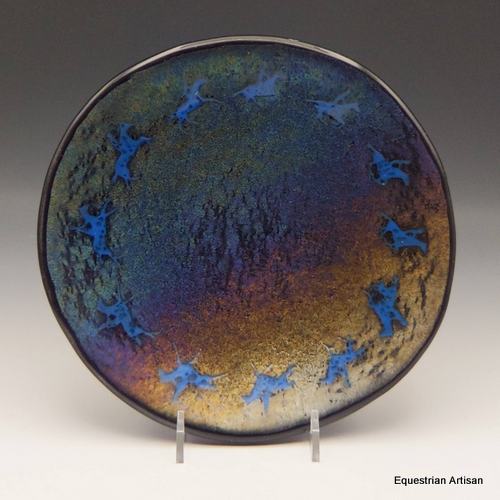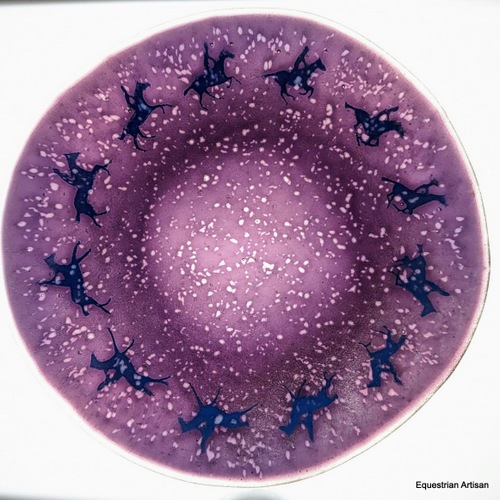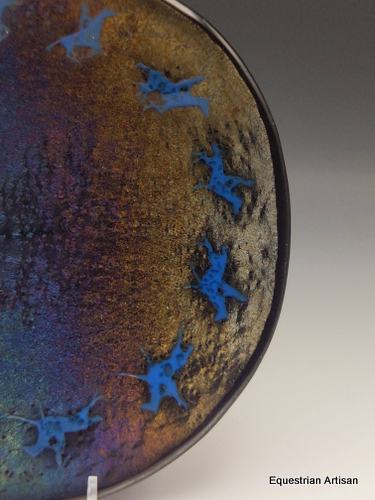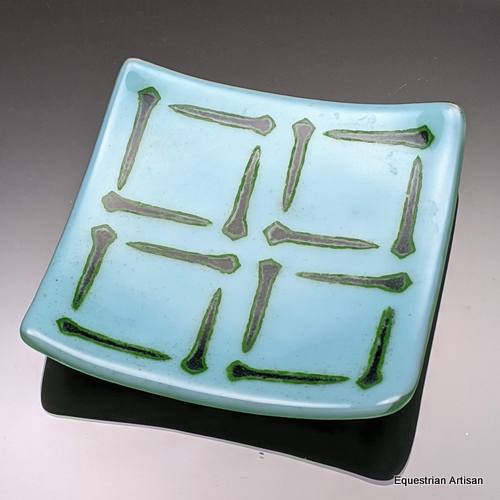Muybridge’s Galloping Horse Bowl On Iridescent Purple Art Glass 8″
$169.00
This bowl is part of our More Horses Collection of equestrian art glass home decor. The design is based on the pioneering work of photographer Charles Muybridge who is famous for his series of stop-motion photographs of a horse’s gallop, which definitively demonstrated that there is a moment during a horse’s stride when all four hooves are off the ground. It is 8″ in diameter.
This one-of-a-kind art glass piece is transparent. Placed in a well-lit window on its included plate stand, you will see its striking dark purple color. When lit from the front, in the absence of direct sunlight, the dynamic galloping horse design is more prominent. This versatile piece is perfect for equestrian enthusiasts and those who appreciate fine artisanal craftsmanship, making it a standout addition for your home or a thoughtful gift for horse-loving friends.
Creating the dish was a 5-step process.
Glass Selection: First two circles of glass were cut to the dimensions of the finished piece, one clear and the other iridescent deep purple.
Painting the Design: The galloping horse was created using a process called “powder printing”. Finely ground opaque blue glass (known as powder frit) was sifted onto the iridized glass using a stencil created on my laser cutter.
Applying Surface Decoration: After lifting the stencil and removing stray glass powder, a layer of medium, clear glass frit (the size of fine gravel) was scattered over the piece to melt and create a ligher shade of purple after firing. This piece of glass was placed on top of the clear circle in preparation for fusing.
Fusing in the Kiln: The two layers were placed in a kiln and heated to 1475 degrees, the temperature at which glass melts and the layers fused together. The high heat also made the paint permanently adhere to the glass. In this case it was held at the top temperature a little longer than is standard, resulting in a dish with more surface texture than we usually see, and supercharged iridescent colors.
Shaping the Dish: At this point the piece was still square. To make it into a dish it needed one more firing. It went back into the kiln, this time on top of a mold, and was heated to 1250 degrees. At this temperature the glass softened and gravity caused it to sink into the mold and assume its final shape.
Description
This bowl is part of our More Horses Collection of equestrian art glass home decor. The design is based on the pioneering work of photographer Charles Muybridge who is famous for his series of stop-motion photographs of a horse’s gallop, which definitively demonstrated that there is a moment during a horse’s stride when all four hooves are off the ground. It is 8″ in diameter.
This one-of-a-kind art glass piece is transparent. Placed in a well-lit window on its included plate stand, you will see its striking dark purple color. When lit from the front, in the absence of direct sunlight, the dynamic galloping horse design is more prominent. This versatile piece is perfect for equestrian enthusiasts and those who appreciate fine artisanal craftsmanship, making it a standout addition for your home or a thoughtful gift for horse-loving friends.
Creating the dish was a 5-step process.
Glass Selection: First two circles of glass were cut to the dimensions of the finished piece, one clear and the other iridescent deep purple.
Painting the Design: The galloping horse was created using a process called “powder printing”. Finely ground opaque blue glass (known as powder frit) was sifted onto the iridized glass using a stencil created on my laser cutter.
Applying Surface Decoration: After lifting the stencil and removing stray glass powder, a layer of medium, clear glass frit (the size of fine gravel) was scattered over the piece to melt and create a ligher shade of purple after firing. This piece of glass was placed on top of the clear circle in preparation for fusing.
Fusing in the Kiln: The two layers were placed in a kiln and heated to 1475 degrees, the temperature at which glass melts and the layers fused together. The high heat also made the paint permanently adhere to the glass. In this case it was held at the top temperature a little longer than is standard, resulting in a dish with more surface texture than we usually see, and supercharged iridescent colors.
Shaping the Dish: At this point the piece was still square. To make it into a dish it needed one more firing. It went back into the kiln, this time on top of a mold, and was heated to 1250 degrees. At this temperature the glass softened and gravity caused it to sink into the mold and assume its final shape.
Additional information
| Weight | 2.5 lbs |
|---|---|
| Dimensions | 12 × 12 × 4 in |














